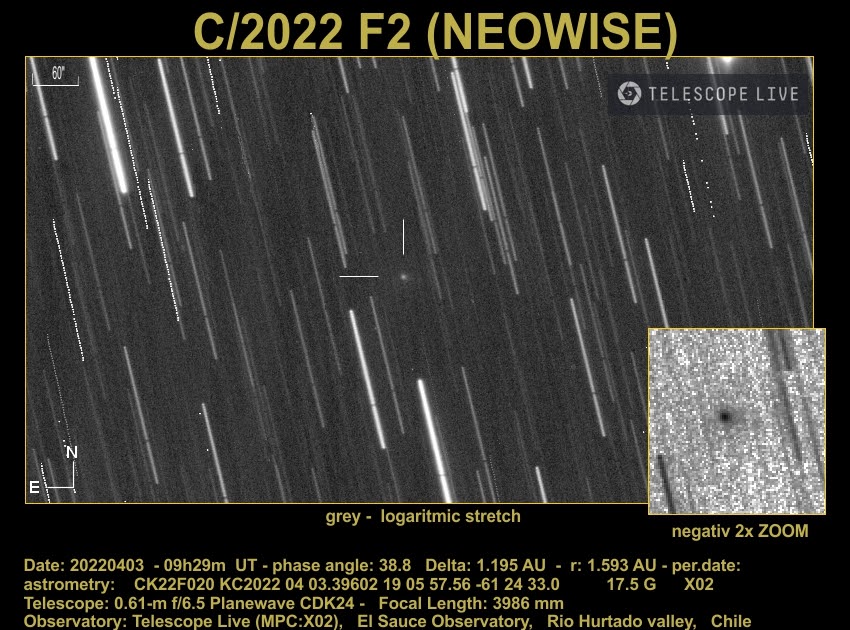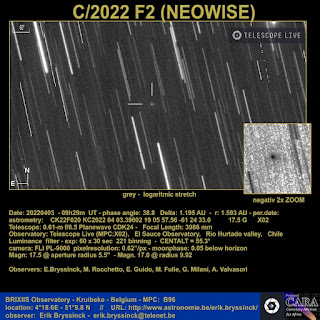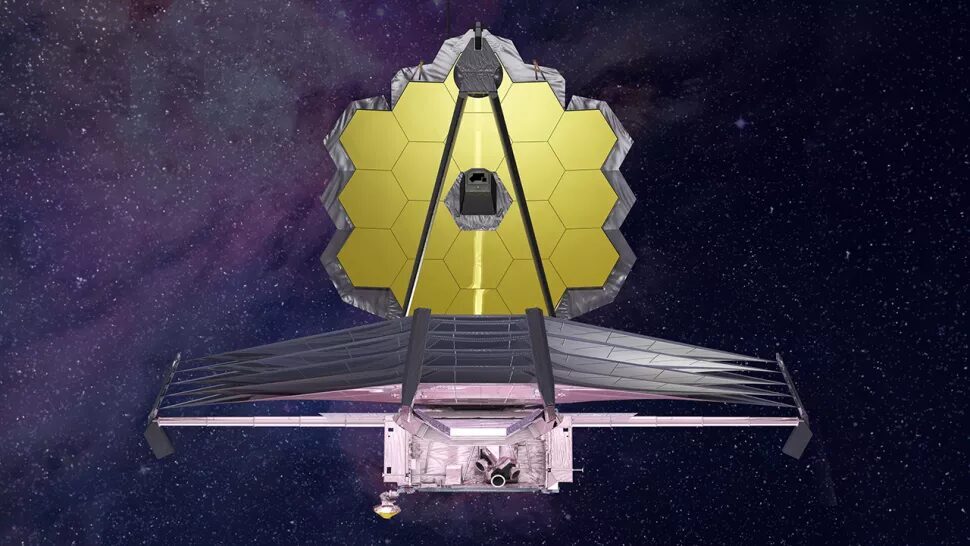You are using an out of date browser. It may not display this or other websites correctly.
You should upgrade or use an alternative browser.
You should upgrade or use an alternative browser.
Near-Earth objects and close calls
- Thread starter Gawan
- Start date
Spain: They capture the explosion of a fireball over the sky of Catalonia.
05/23/2022
05/23/2022
Fraser Cain Universe Today
Update on the Potential May 31st tau Herculid Meteor Storm
Comet C/2021 O3
Here's a new updated information about the upcoming possibly massive meteor shower that will happen in the end of May. The exact time is around May 31 at 4h-5h UT. But recalculate for your local time. It will be mostly visible in continental USA and Mexico. Looks like in some states it will still be 30th of May. Essencially, it will be the night of 30-31st of May. Don't forget to look up!
Electronic Telegram No. 5125
Central Bureau for Astronomical Telegrams
Mailing address: Hoffman Lab 209; Harvard University;
20 Oxford St.; Cambridge, MA 02138; U.S.A.
e-mail: cbatiau@eps.harvard.edu (alternate cbat@iau.org)
Central Bureau for Astronomical Telegrams
Prepared using the Tamkin Foundation Computer Network
TAU HERCULID METEOR SHOWER 2022 P. Jenniskens, SETI Institute and NASA Ames Research Center; Q. Ye, University of Maryland and Boston University; and J. Vaubaillon, I.M.C.C.E, Observatory of Paris, report that a meteor outburst of tau Herculid meteors (IAU shower 61) is anticipated for May 31 around 4h-5h UT this year. This outburst is unusual in that the debris was generated during the 1995 breakup of comet 73P/Schwassmann-Wachmann (cf., Luethen et al. 2001, J. Intl. Meteor Organization 29, 15-28). Independent calculations at I.M.C.C.E. and the University of Maryland, using slightly different inputs, now put the 1995 dust trail in the earth's path with an expected peak on May 31d05h01m and 03h52m UT, respectively. In both models, meteors will radiate from R.A. = 209 deg, Decl. = +28 degrees with an apparent velocity of 16.4 km/s (geocentric velocity 12.1 km/s). The outburst is expected to last about two hours. Observers in the continental USA and Mexico are most favorably located to see this event in new-moon conditions, with a radiant high in the northwest.
The authors note that there are two caveats. First, an unusual meteor shower will only happen if the meteoroid ejection velocities during the breakup and decay of fragments were a factor of 2.5 higher than under normal cometary ejection conditions. Because the comet itself is not near the earth, normal ejection does not have the meteoroids disperse far enough ahead of the comet to intersect the earth's path. The higher gas-production rate of comet 73P in 1995 suggests that ejection velocities may have been higher by up to a factor of 2.7. However, the ejection velocities of cm- and mm-sized meteoroids were not measured in 1995. Second, if the outburst happens, the meteors will be mostly faint. Rare tau Herculids are also known from regular cometary activity during normal returns. The Cameras for Allsky Meteor Surveillance (CAMS) project, which triangulates video-detected meteors visible to the naked eye, measured the orbit of 18 tau Herculids during dust-trail crossings in 2011, 2017/ and 2019; from this, the authors calculate a steep magnitude-distribution index of 5.4 +/- 1.1, meaning that there were five times more meteors of magnitude +4 than +3, five times more meteors of mag +3 than +2, etc. -- but with the camera sensitivity such that more meteors of magnitude +3 were detected. In practice, a few meteors were of magnitude +1, but most were near the +4 magnitude detection limit of the video cameras.
Calculations at the University of Maryland show that when the earth crosses the meteoroid stream, a very faint glow from scattered sunlight may be visible in the sky centered around R.A. = 170 deg, Decl. = +20 deg in Leo, and around R.A. = 355 deg, Decl. = -15 deg in the opposite direction in Equ. Finally, two dust trails from the normal 1892 and 1897 returns of 73P will also be in the earth's path around 16h UT on May 30 and 10h UT on May 31, respectively (cf., Wiegert et al. 2005, MNRAS 361, 638). Because the comet has been known only since 1930, these trail crossings could shed new light onto the past activity of the comet, if detected.
Last edited:
53 reports of a fireball seen over MA, ME, NH, NY, Québec, Quebec and VT on Sunday May 29, 2022 around 02:16 UT.
Just to update that nothing on the cameras so far. They say that the speed of the meteorites may be too slow to register on the camera. Or it is one massive bust.  Maybe the Universe has a sense of humor.
Maybe the Universe has a sense of humor.  But there are still 4 hours to go until the predicted end of the potential shower peak, so everyone is still glued to the screen.
But there are still 4 hours to go until the predicted end of the potential shower peak, so everyone is still glued to the screen.
Interestingly enough, people in the chats say that they saw falling meteors in various locations in the US, so maybe the cameras are looking in the wrong direction. Here's another stream where they also share various interesting information. And the astronomer who runs the channel *ghasp* believes in panspermia and that there is life on other planets.
Here's another stream where they also share various interesting information. And the astronomer who runs the channel *ghasp* believes in panspermia and that there is life on other planets. 
Added: Ok, now it makes sense. The astronomer who runs the stream is Marc D'Antonio. He is "the Mutual UFO Network’s (MUFON) Chief Photo/Video Analyst and is CEO of FX Models, a company specializing in digital/physical models, and organic special effects in the film industry. His degree is in Astronomy and he specializes in the study of Exoplanets."
 Maybe the Universe has a sense of humor.
Maybe the Universe has a sense of humor. Interestingly enough, people in the chats say that they saw falling meteors in various locations in the US, so maybe the cameras are looking in the wrong direction.

Added: Ok, now it makes sense. The astronomer who runs the stream is Marc D'Antonio. He is "the Mutual UFO Network’s (MUFON) Chief Photo/Video Analyst and is CEO of FX Models, a company specializing in digital/physical models, and organic special effects in the film industry. His degree is in Astronomy and he specializes in the study of Exoplanets."
Last edited:
SpaceWeather.com reported
THE TAU HERCULID METEOR SHOWER ACTUALLY HAPPENED: Forecasters were right. Debris from Comet 73P/Schwassmann-Wachmann-3 did hit Earth last night. Observers across North America witnessed the resulting display of tau Herculid meteors. It was not a meteor storm, as some had hoped, but instead a gentle shower punctuated by bright flurries.
Many observers reporting to Spaceweather.com say the meteors were slow, they shined as brightly as 2nd to 4th magnitude stars, and their tails traced back to a radiant near Arcturus. These characteristics are in accord with debris coming from Comet 73P's breakup in 1995.
The Canadian Meteor Orbit Radar (CMOR) in western Ontario detected more than 30 slow tau Herculids. Take a look at their radar sky map; all of the meteors were clustered near Arcturus, as expected. Independent radio data reported by Japanese astronomers reveal two peaks of tau Herculid activity, perhaps linked to two distinct debris streams from Comet 73P/Schwassmann-Wachmann 3. It is noteworthy that these radio and radar detections include very small meteoroids too faint to see with the unaided eye.
DAYTIME METEOR SHOWER UNDERWAY

One of the strongest meteor showers of the year is underway. You might not notice, though, because of the glare. The Canadian Meteor Orbit Radar (CMOR) is picking up significant activity less than 20 degrees from the sun.
Its source is sungrazing Comet 96P/Machholz, which has laid down a trail of debris in the early-June portion of Earth's orbit. When the shower peaks on June 7th, CMOR will detect approximately one Arietid every 20 seconds--a rate which ranks the Arietids among the top meteor showers of the year.
It turns out that June is the best month of the year for daytime meteor showers. When the Arietids subside, another daytime shower will take over: The zeta Perseids (ZPE) peak on June 13th. And then another: The beta Taurids on June 29th. If only we could see them...
The Consortium studies the current with the past comet and asteroid dust 


New podcast How many #METEORITOS are cataloged worldwide? What is their origin? And their type and size? answer:
@Josep_Trigo @J_Garcia_Guinea @mncn_csic #DíaInternacionaldelosAsteroides (June 30) @rne @ARTUROMARTINRNE
http://play.rtve.es/a/6559838

 remanzacco.blogspot.com
remanzacco.blogspot.com
Stacking of 60 unfiltered exposures, 30 seconds each, obtained remotely on 2022, April 3.3 from X02 (Telescope Live, Chile) through a 0.61-m f/6.5 astrograph + CCD, shows that this object is a comet with a central condensation inside a coma of diameter 19" and a hint of a broad tail 13" long in p.a. 283 degrees, with magnitude of 17.5-17.7 in an aperture of radius 5".5 (Observers E. Bryssinck, M. Rocchetto, E. Guido, M. Fulle, G. Milani, G. Savini, A. Valvasori).
Our confirmation image (click on the images for a bigger version)

CBET 5113 assigns the following parabolic orbital elements to comet C/2022 F2 (NEOWISE): T 2022 Mar. 24.47; e= 0.99; Peri. = 201.41; q = 1.59 ; Incl.= 97.47 by Ernesto Guido

Posted by Paul Roggemans | Jun 3, 2022 | Meteor Library, News |
New podcast How many #METEORITOS are cataloged worldwide? What is their origin? And their type and size? answer:
@Josep_Trigo @J_Garcia_Guinea @mncn_csic #DíaInternacionaldelosAsteroides (June 30) @rne @ARTUROMARTINRNE
http://play.rtve.es/a/6559838

New Comet C/2022 F2 (NEOWISE)
CBET 5113 & MPEC 2022-G83 , issued on 2022, April 06, announce the discovery of a comet (magnitude ~17) in infrared exposures obtained duri...
Tuesday, May 31, 2022
New Comet C/2022 F2 (NEOWISE)
CBET 5113 & MPEC 2022-G83, issued on 2022, April 06, announce the discovery of a comet (magnitude ~17) in infrared exposures obtained during Mar. 30-Apr. 1 UT with the Near-Earth Object Wide-field Infrared Survey Explorer (or NEOWISE; formerly the WISE earth-orbiting satellite). The new comet has been designated C/2022 F2 (NEOWISE).Stacking of 60 unfiltered exposures, 30 seconds each, obtained remotely on 2022, April 3.3 from X02 (Telescope Live, Chile) through a 0.61-m f/6.5 astrograph + CCD, shows that this object is a comet with a central condensation inside a coma of diameter 19" and a hint of a broad tail 13" long in p.a. 283 degrees, with magnitude of 17.5-17.7 in an aperture of radius 5".5 (Observers E. Bryssinck, M. Rocchetto, E. Guido, M. Fulle, G. Milani, G. Savini, A. Valvasori).
Our confirmation image (click on the images for a bigger version)

CBET 5113 assigns the following parabolic orbital elements to comet C/2022 F2 (NEOWISE): T 2022 Mar. 24.47; e= 0.99; Peri. = 201.41; q = 1.59 ; Incl.= 97.47 by Ernesto Guido
News from the meteor library: dust trail of comet 17P/Holmes
Evolution of the dust trail of comet 17P/Holmes
This article has been accepted for publication in the Monthly Notices of the Royal Astronomical Society, submitted by Maria Gritsevich, Markku Nissinen, Arto Oksanen, Jari Suomela and Elizabeth A. SilberPosted by Paul Roggemans | Jun 3, 2022 | Meteor Library, News |
Abstract:
The massive outburst of the comet 17P/Holmes in 2007 October is the largest known outburst by a comet thus far. We present a new comprehensive model describing the evolution of the dust trail produced in this phenomenon. The model comprises of multiparticle Monte Carlo simulation including the solar radiation pressure effects, gravitational disturbance caused by Venus, Earth and Moon, Mars, Jupiter and Saturn, and gravitational interaction of the dust particles with the parent comet itself. Good accuracy of computations is achieved by its implementation in Orekit, which executes Dormad-Prince numerical integration methods with higher precision. We demonstrate performance of the model by simulating particle populations with sizes from 0.001 to 1 mm with corresponding spherically symmetric ejection speed distribution, and towards the Sun outburst modelling.
The model is supplemented with and validated against the observations of the dust trail in common nodes for 0.5 and 1 revolutions. In all cases, the predicted trail position showed a good match to the observations. Additionally, the hourglass pattern of the trail was observed for the first time within this work. By using variations of the outburst model in our simulations, we determine that the assumption of the spherical symmetry of the ejected particles leads to the scenario compatible with the observed hourglass pattern. Using these data, we make predictions for the two-revolution dust trail behaviour near the outburst point that should be detectable by using ground-based telescopes in 2022.
You can download this paper for free: Evolution of the dust trail of comet 17P/Holmes (14 pages).
Chad
The Living Force
One to keep an eye on: NASA's James Webb Space Telescope was hit by a micrometeoroid that was much larger than they'd modeled for, and it struck earlier than they had expected (6 months after launch).
In addition it sounds like it might send back some pretty nifty images come July 12th.
In addition it sounds like it might send back some pretty nifty images come July 12th.
First micrometeoroid impact hits James Webb Space Telescope just months into flight

First micrometeoroid impact hits James Webb Space Telescope just months into flight
NASA's next-generation space observatory has sustained its first noticeable micrometeoroid impact less than six months after launch, but the agency isn't too concerned. The James Webb Space Telescope, also known as Webb or JWST, launched on Dec....www.sott.net
Meghan Bartels
Space
Wed, 08 Jun 2022 22:00 UTC
© Northrop Grumman
An artist's depiction of the James Webb Space Telescope at work.
NASA's next-generation space observatory has sustained its first noticeable micrometeoroid impact less than six months after launch, but the agency isn't too concerned.
The James Webb Space Telescope, also known as Webb or JWST, launched on Dec. 25, 2021. It has spent the intervening months trekking out to its deep-space post and preparing for science observations, a complicated process that has gone remarkably smoothly; recently, NASA said it expects to unveil the first science-quality images from the telescope on July 12.
Now, the agency announced on Wednesday (June 8) that the observatory has experienced its first few impacts from tiny pieces of space debris called micrometeoroids. But don't panic: Neither the observatory's schedule nor its scientific legacy is expected to suffer.
"With Webb's mirrors exposed to space, we expected that occasional micrometeoroid impacts would gracefully degrade telescope performance over time," Lee Feinberg, Webb optical telescope element manager at NASA's Goddard Space Flight Center in Maryland, said in the statement. "Since launch, we have had four smaller measurable micrometeoroid strikes that were consistent with expectations, and this one more recently that is larger than our degradation predictions assumed."
The most serious of the impacts occurred between May 23 and May 25 and affected the C3 segment of the 18-piece gold-plated hexagonal primary mirror, according to the statement.
All spacecraft are expected to experience and designed to withstand micrometeoroid impacts, and JWST is no different. The observatory's engineers even subjected mirror samples to real impacts to understand how such events might affect the mission's science.
However, the recent impact was larger than those that mission personnel had modeled or could test on the ground, according to the statement.
Despite the impact coming so early in the observatory's tenure, NASA officials are confident that the $10 billion telescope will still perform adequately.
Comment: They're 'confident' despite the impact being much larger and coming earlier than they'd expected: Russian space surveillance station records space activity surge in 2021
"We always knew that Webb would have to weather the space environment, which includes harsh ultraviolet light and charged particles from the sun, cosmic rays from exotic sources in the galaxy, and occasional strikes by micrometeoroids within our solar system," Paul Geithner, technical deputy project manager at NASA Goddard, said in the statement. "We designed and built Webb with performance margin — optical, thermal, electrical, mechanical — to ensure it can perform its ambitious science mission even after many years in space."
In addition, JWST launched with its optics in even better shape than the agency bargained for, officials noted in the statement.
Some micrometeoroid impacts can be predicted, officials wrote. For example, when the spacecraft is set to fly through known meteor showers, personnel can maneuver JWST's optical systems into safety for these events. However, the recent impact was not part of such a meteor shower and the statement classified it as "an unavoidable chance event."
After an impact occurs, engineers can individually adjust the 18 primary mirror segments on the observatory to keep the mirror as a whole finely tuned.
As the JWST team continues to evaluate the impact, NASA is focused on better understanding both the particular event and the environment that the observatory will experience throughout its mission. The telescope is orbiting what scientists call the Earth-sun Lagrange point 2, located nearly 1 million miles (1.5 million kilometers) away from Earth in the direction opposite the sun.
"We will use this flight data to update our analysis of performance over time and also develop operational approaches to assure we maximize the imaging performance of Webb to the best extent possible for many years to come," Feinberg said.
Email Meghan Bartels at mbartels@space.com or follow her on Twitter @meghanbartels (opens in new tab). Follow us on Twitter @Spacedotcom (opens in new tab) and on Facebook (opens in new tab).
Trending content
-
-
Thread 'Coronavirus Pandemic: Apocalypse Now! Or exaggerated scare story?'
- wanderingthomas
Replies: 30K -
Thread 'Mass Shooting at Bondi Beach, Sydney, targets Jews celebrating Hanukkah'
- Rhythmik
Replies: 111 -

